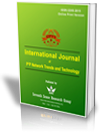Contrast Enhancement for Emissive Display Using Histogram Equalization and Bilateral Tone Adjustment
 |
International Journal of P2P Network Trends and Technology (IJPTT) |  |
| © 2013 by IJPTT Journal | ||
| Volume-3 Issue-3 |
||
| Year of Publication : 2013 | ||
| Authors : Aruna.L ,S.S.Thamilselvi |
Citation
Aruna.L ,S.S.Thamilselvi."Contrast Enhancement for Emissive Display Using Histogram Equalization and Bilateral Tone Adjustment". International Journal of P2P Network Trends and Technology (IJPTT), V3(3):18 - 24 May - Jun 2013, ISSN:2249-2615, www.ijpttjournal.org. Published by Seventh Sense Research Group.
Abstract
By minimizing the objective function based on the convex optimization theory its found that the proposed algorithm achieves contrast enhancement and power saving simultaneously. Then the bilateral tone adjustment technique is used to improve the image quality. BiTA is applied to the luminance, while the color saliency detector calculates the amount of saliency of each pixel with respect to neighbourhood. Saliency produces a saliency map with well defined boundary of salient object. Regions with higher saliency values indicate that the regions have a higher extent of human interest deserve a greater degree of enhancement. Saliency Weighted Contrast Enhancement is then performed based on the adjusted luminance and saliency. The Simulation results demonstrate that the Bilateral Tone Adjustment Technique can reduce power consumption significantly while improving image contrast and perceptual quality.
References
[1] R. C. Gonzalez and R. E. Woods, Digital Image Processing, 3rd ed. Upper Saddle River, NJ: Prentice-Hall, 2007.
[2] W.-C. Cheng, Y. Hou, and M. Pedram, “Power minimization in a backlit TFT-LCD display by concurrent brightness and contrast scaling,” IEEE Transaction on Consumer Electron., vol. 50, no. 1, pp. 25–32, Feb. 2004.
[3] P.-S. Tsai, C.-K. Liang, T.-H. Huang, and H. H. Chen, “Image enhancement for backlight-scaled TFT-LCD displays,” IEEE Transaction Circuits System Video Technology., vol. 19, no. 4, pp. 574–583, Apr. 2009.
[4] S. R. Forest, “The road to high efficiency organic light emitting devices,” Organic Electron., vol. 4, no. 2/3, pp. 45–48, Sep. 2003
[5] I. Choi, H. Shim, and N. Chang, “Low-power color TFT LCD display for hand-held embedded systems,” in Process Low Power Electron., 2002, pp. 112–117.
[6] J. Stark, “Adaptive image contrast enhancement using generalizations of histogram equalization,” IEEE Transaction on Image Processing., vol. 9, no. 5, pp. 889–896, May 2000.
[7] Z. Yu and C. Bajaj, “A fast and adaptive method for image contrast enhancement,” in IEEE ICIP, Oct. 2004, vol. 2, pp. 1001–1004.
[8] T. K. Kim, J. K. Paik, and B. S. Kang, “Contrast enhancement system using spatially adaptive histogram equalization with temporal filtering,” IEEE Transaction Consumer Electron., vol. 44, no. 1, pp. 82–87, Feb. 1998.
Keywords
- image/video quality enhancement, emissive display, histogram equalization(HE), histogram modification(HM), Power saving, probability density function,saliency.

